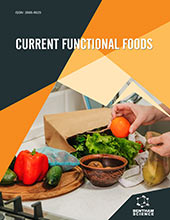- Home
- A-Z Publications
- Current Functional Foods
- Previous Issues
- Volume 1, Issue 2, 2023
Current Functional Foods - Volume 1, Issue 2, 2023
Volume 1, Issue 2, 2023
-
-
Exploration and Evaluation of In-vitro Antioxidant Activity of ABANA: A Polyherbal Formulation
More LessAuthors: Deepak Bharati and Abhijeet PuriObjective The purpose of this study was to determine the antioxidant capacity of Abana® (a poly-ingredient formulation with natural constituents). Methods Extensive ethanol extraction of polyherbal formulations was followed by fractionation into petroleum ether, chloroform, and ethyl acetate extracts. Various fractions were further analyzed using this conventional method for phytochemical composition and concentration-dep Read More
-
-
-
Pharmacognostical, Phytochemical, In vitro Anti-obesity Studies, and Toxicity Analysis of Momordica charantia Linnaeus Fruits from Haryana
More LessAuthors: Vinesh Dahiya, Neeru Vasudeva, Sunil Sharma and Ashok KumarBackground Momordica charantia Linnaeus (Cucurbitaceae family), known as bitter melon is an annual climbing vine, that grows in tropical regions and its fruits are consumed as a vegetable in Asian countries. Traditionally various parts of the plant such as fruits, seeds, leaves, flowers, etc. have been used for medicinal purposes. Its fruit is used as an anti-diabetic, laxative, anthelmintic, emetic, and anti-obesity, for respiratory pro Read More
-
-
-
Food Fortification Using Essential Fatty Acids and Antioxidants: A Short Review
More LessAuthors: Sameera Rege, Megha Varshneya and Shamim MominHealth is wealth’ is an old saying. It implies that good health is more important than wealth. Food influences health conditions. A balanced nutritious diet is the key to good health. Consumption of non-nutritious food causes malnutrition because of insufficient nutrients. Prolonged deficiencies of certain nutrients lead to serious problems. When the deficiencies are detected, they can be recovered by proper supplementation base Read More
-
-
-
Potential Oncotherapeutic Effects of Nutraceuticals against Hepatocellular Carcinoma: Recent Advancements
More LessAuthors: Arghadip Das, Supravat Das, Sanchari Bhattacharya, Debjeet Sur, Samrat Bose and Tilottama MukherjeeBackground Worldwide, Hepatocellular carcinoma (HCC) is a frequently diagnosed cancer, having significant variations in its epidemiology. It ranks as the sixth prevailing neoplasm and is considered the third leading cause of mortality due to cancer. It accounts for 90% of primary liver cancers. Till date, an effective prevention or treatment is absent except for liver resection, chemotherapy and a frequently applied drug -sorafeni Read More
-
-
-
Pharmacological Investigation on Unraveling Mechanism of Action of Quisqualis indica Leaves for Predicted Treatment of Peptic Ulcer Disease
More LessBackground With the aid of various ulcer-induced models, the goal of this study was to assess the antiulcer ability of Quisqualis indica (Q. indica) leaf extracts in Wistar rats. Methods The induction of ulcers was done by different models like pylorus ligation method, ethanol-induced and stress-induced models. Group 1 (negative control), Group 2 (standard group) were treated with Sucralfate (8.6 mg/kg), Group 3 was treated wi Read More
-
-
-
Green Tea (Camellia sinensis) Extract is Effective against Biofilms of Staphylococcus aureus and Pseudomonas aeruginosa, and Interferes on the Activity of Antimicrobial Drugs
More LessBackground Given the lack of options for treating infectious diseases, it is urgent to explore new antimicrobials. Plant food historically represents relevant sources of antimicrobial molecules. Objective Here, we show that green tea can eradicate biofilms and planktonic cells of clinical isolates of Staphylococcus aureus and Pseudomonas aeruginosa. Methods We conducted in vitro antimicrobial activity tests (MIC, MBC, MBEC). C Read More
-
-
-
A Critical Review of Phytochemical, Pharmacological and Ethnomedicinal Properties of Eryngium foetidum L.
More LessEryngium foetidum L. is a biennial herb widely used in most tropical regions as a herb, and in India, its use is essentially increasing as an aromatic spice and flavouring agent. The plant is widely populated by Turkey, Southeast Asia, the Caribbean, Thailand, China, and others. This herb is becoming more popular due to its traditional uses for various ailments. Reviews have been included in peer-reviewed publications until 2 Read More
-
Volumes & issues
Most Read This Month
Article
content/journals/cff
Journal
10
5
false
en


